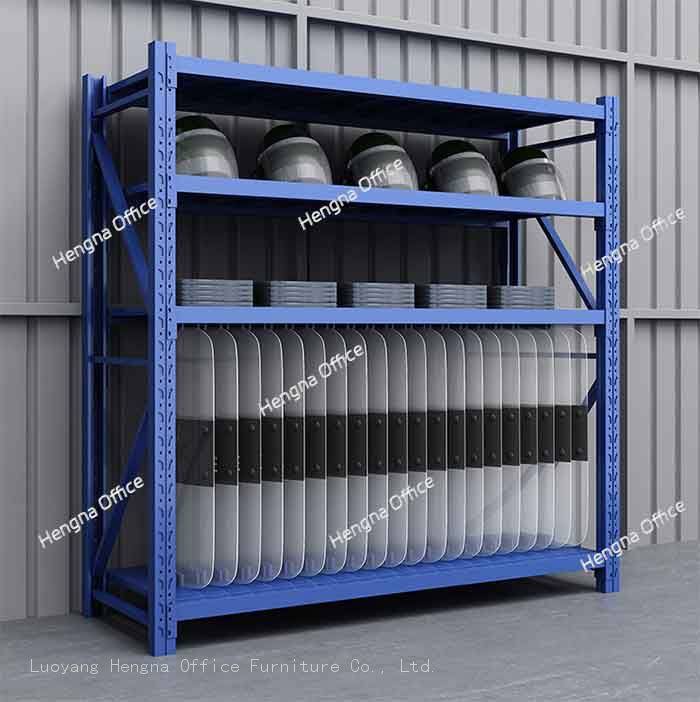Home > Blog > Choosing Between Medium & Heavy Duty Racking: What 200-400kg Capacity Means for Your Storage Needs
-
 Sarah
Hi there! Welcome to my shop. Let me know if you have any questions.
Sarah
Hi there! Welcome to my shop. Let me know if you have any questions.
Your message has exceeded the limit.

Choosing Between Medium & Heavy Duty Racking: What 200-400kg Capacity Means for Your Storage Needs
2025-10-22 18:54:18
Selecting the appropriate racking system is one of the most important decisions warehouse managers, business owners, and facility operators face. The choice between medium duty and heavy duty racking in the 200-400kg capacity range can significantly impact your operational efficiency, safety, and overall costs. This comprehensive guide will help you navigate this critical decision by breaking down exactly what these capacity ratings mean in practical terms and providing a clear framework for choosing the perfect system for your specific storage requirements.
Demystifying Capacity Ratings: Beyond the Numbers
When manufacturers rate their racking systems at 200-400kg per shelf, these numbers represent carefully calculated load limits that consider numerous engineering factors. Understanding what these ratings truly mean is essential for making an informed decision.
Engineering Behind the Ratings:
Material Strength: The thickness and quality of steel used in construction
Structural Design: How the frame, beams, and connections work together
Safety Factors: Built-in margins that ensure the system can handle loads beyond stated limits
Testing Standards: Industry-standard testing procedures that verify capacity claims

Real-World Capacity Considerations:
The stated capacity assumes ideal conditions. In practice, several factors can affect the actual safe load capacity:
| Factor | Impact on Capacity | Recommendation |
|---|---|---|
| Load Distribution | Uneven weight reduces effective capacity | Distribute weight evenly across shelf surface |
| Dynamic Loading | Frequent loading/unloading creates stress | Reduce stated capacity by 20-30% for dynamic use |
| Environmental Conditions | Humidity, temperature, and chemicals affect materials | Choose appropriate materials for your environment |
Installation Quality: Proper assembly is crucial for achieving rated capacity | Professional installation recommended for critical applications |
Medium Duty Racking: Analyzing the 200-300kg Range
Medium duty racking systems occupy the sweet spot for many applications, offering substantial capacity without the premium cost of heavy duty systems.
Technical Specifications:
Capacity Range: 200-300kg per shelf (440-660 lbs)
Material Thickness: Typically 0.8-1.2mm for columns and beams
Shelf Span: Usually up to 1500mm without additional support
Weight per Unit: Approximately 25-35kg per bay (depending on size)
Performance Characteristics:
Medium duty systems excel in environments where versatility and cost-effectiveness are prioritized over maximum load capacity:
Installation Efficiency: Most systems feature tool-free assembly, reducing installation time by up to 70%
Space Optimization: Designed to maximize storage density while maintaining accessibility
Reconfigurability: Easy to modify or expand as storage needs change
Maintenance Requirements: Generally lower maintenance needs due to lighter construction
Cost-Benefit Analysis:
The economics of medium duty racking make it attractive for many businesses:
Initial Investment: 30-40% less expensive than heavy duty alternatives
Installation Costs: 50-60% lower due to simpler assembly requirements
Return on Investment: Typically 12-18 months for most commercial applications
Lifespan: 5-8 years with proper maintenance in moderate-use environments
Heavy Duty Racking: Understanding the 300-400kg Range
Heavy duty racking systems provide enhanced strength and durability for more demanding applications, justifying their higher initial cost through superior performance and longevity.
Technical Specifications:
Capacity Range: 300-400kg per shelf (660-880 lbs)
Material Thickness: Typically 1.2-1.5mm for columns and beams
Shelf Span: Can accommodate up to 1800mm without additional support
Weight per Unit: Approximately 40-55kg per bay (depending on size)
Enhanced Engineering Features:
Heavy duty systems incorporate additional design elements to ensure superior performance:
Reinforced Connections: Embedded tighter and stronger connection systems that prevent loosening
Advanced Load Distribution: Engineered to handle point loads and uneven weight distribution
Superior Stability: Additional bracing and support structures for enhanced safety
Extended Adjustability: More precise shelf positioning options for optimal space utilization
Long-Term Value Proposition:
While heavy duty racking requires a higher initial investment, it delivers superior long-term value:
Durability: 10-15 year lifespan even in demanding environments
Reduced Replacement Costs: Less frequent need for system replacement or upgrade
Higher Resale Value: Better retention of value if business needs change
Lower Total Cost of Ownership: When factoring in maintenance and replacement costs
Application Analysis: Matching Systems to Needs
The choice between medium and heavy duty racking ultimately depends on your specific application requirements. Let’s analyze common use cases to determine the best fit.
Retail and Commercial Applications:
| Application | Recommended System | Rationale |
|---|---|---|
| General Merchandise Storage | Medium Duty (200-300kg) | Cost-effective for typical retail inventory |
| Beverage and Bulk Storage | Heavy Duty (300-400kg) | Handles heavy cases and bulk items |
| Seasonal Inventory | Medium Duty | Flexibility for changing inventory types |
| High-Value Items | Heavy Duty | Enhanced security and stability for valuable goods |
Industrial and Manufacturing Environments:
| Application | Recommended System | Rationale |
|---|---|---|
| Tool Storage | Heavy Duty (300-400kg) | Supports heavy power tools and equipment |
| Parts Organization | Medium Duty (200-300kg) | Adequate for most parts and components |
| Raw Material Storage | Heavy Duty | Handles heavy raw materials and supplies |
| Work-in-Progress | Medium to Heavy Duty | Depends on specific product weight |
Institutional Applications:
| Application | Recommended System | Rationale |
|---|---|---|
| Educational Supplies | Medium Duty (200-300kg) | Suitable for books and teaching materials |
| Medical Equipment Storage | Heavy Duty (300-400kg) | Supports heavy medical devices and supplies |
| Archive Storage | Heavy Duty | Handles heavy document boxes and records |
| Athletic Equipment | Heavy Duty | Accommodates heavy sports equipment and gear |
Installation and Maintenance Considerations
The ease of installation and ongoing maintenance requirements should factor heavily into your decision between medium and heavy duty racking systems.
Installation Complexity Comparison:
| Factor | Medium Duty | Heavy Duty |
|---|---|---|
| Assembly Time | 1-2 hours per unit | 2-3 hours per unit |
| Skill Requirements | Basic DIY skills | Intermediate mechanical skills |
| Tools Required | Minimal (often tool-free) | Basic hand tools |
| Personnel Needed | Often 1 person | Usually 2 people |
| Reconfiguration Ease | High | Moderate |
Maintenance Requirements:
Both system types require regular maintenance, but the intensity and frequency differ:
Medium Duty Systems:
Monthly visual inspections for loose connections
Quarterly load capacity verification
Annual professional inspection recommended
Typical maintenance cost: 5-8% of initial investment annually
Heavy Duty Systems:
Bi-weekly visual inspections for high-use environments
Monthly load capacity verification
Semi-annual professional inspection recommended
Typical maintenance cost: 3-5% of initial investment annually
Decision Framework: Choosing Your Perfect System
To simplify the selection process, use this comprehensive decision framework based on your specific requirements and constraints.
Step 1: Assess Your Load Requirements
Calculate the weight of your heaviest items
Determine average load per shelf
Consider load distribution patterns
Factor in dynamic vs. static loading
Step 2: Evaluate Usage Patterns
Frequency of loading/unloading cycles
Number of users accessing the system
Environmental conditions (temperature, humidity, chemicals)


Growth projections for the next 3-5 years
Step 3: Analyze Budget Constraints
Initial investment capacity
Available installation resources
Ongoing maintenance budget
Expected return on investment timeline
Step 4: Consider Future Flexibility
Likelihood of changing storage needs
Potential for business expansion
Possibility of relocating operations
Need for system reconfiguration
Decision Matrix:
| If your situation is… | Then choose… | Because… |
|---|---|---|
| Light to medium loads, budget-conscious | Medium Duty | Cost-effective with adequate capacity |
| Heavy items, high-frequency use | Heavy Duty | Superior strength and durability |
| Mixed inventory types | Medium Duty with some Heavy Duty | Balanced approach for diverse needs |
| Rapidly growing business | Heavy Duty | Better long-term value and expandability |
| Temporary or seasonal storage | Medium Duty | Lower initial investment for short-term use |
Making the Right Investment for Your Storage Future
Choosing between medium duty and heavy duty racking in the 200-400kg capacity range is a decision that will impact your operations for years to come. By understanding exactly what these capacity ratings mean and carefully evaluating your specific requirements, you can select a system that delivers optimal performance, safety, and value.
Remember that the lowest initial cost doesn’t always represent the best long-term value. Consider the total cost of ownership, including installation, maintenance, and potential replacement costs. Heavy duty systems, while more expensive initially, often deliver superior long-term value in demanding environments.
The modern innovations in racking technology, particularly the butterfly snap design and tool-free adjustability, have made both medium and heavy duty systems more accessible and user-friendly than ever before. Take advantage of these advancements by selecting a system that not only meets your current needs but can adapt and grow with your business.
Tags: Medium & Heavy Duty Racking, Choosing Medium Duty Racking, Choosing Heavy Duty Racking

